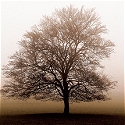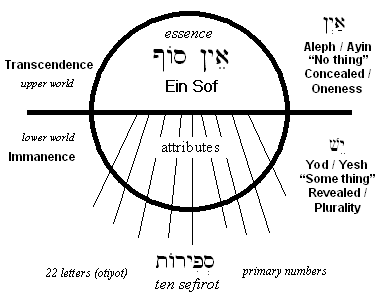|
Tzimtzum - Creation "Out of Nothing"
In the beginning there was only God... and nothing else. God, or Ein Sof, was an all-encompassing Divine Presence/Light called Or Ein Sof (the Light of Infinity). Since nothing but God existed before creation, when God decided to create yesh (i.e., "something") from its Ein (i.e., "nothing"), God needed to "make a space" or to "provide room" for that which was not God (i.e., otherness). God therefore "emptied himself" by contracting his infinite light to create a conceptual space for the creation of the universe. In a great cosmic flash, God then "condensed" into a point of infinite density and infinite energy called tzimtzum (ū”ų┤ū×ų░ū”ūĢų╝ūØ, "contraction") and "exploded out" in all directions (i.e., the cosmic "Big Bang"). In a sense, this self-imposed "contraction"of the Infinite Light is a picture of God "sacrificing" Himself for the sake of creation.
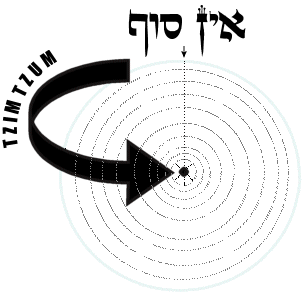
Here's how Isaac Luria (the Ari) describes the doctrine of tzimtzum:
Prior to Creation, there was only the infinite Or Ein Sof filling all existence. When it arose in G-d's Will to create worlds and emanate the emanated...He contracted (in Hebrew "tzimtzum") Himself in the point at the center, in the very center of His light. He restricted that light, distancing it to the sides surrounding the central point, so that there remained a void, a hollow empty space, away from the central point... After this tzimtzum... He drew down from the Or Ein Sof a single straight line [of light] from His light surrounding [the void] from above to below [into the void], and it chained down descending into that void.... In the space of that void He emanated, created, formed and made all the worlds. - Isaac Luria, Etz Chaim
This mysterious decision to create space is associated with the first "emanation" (sefirah) from God is called Keter, or crown (see later). God then created "vessels" (kelim) in the empty space, but when the Divine Light began to radiate into them, they shattered. This is called the "shattering of the vessels" (Shevirat Ha-Kelim) in Lurianic Kabbalah. The shards of the shattered vessels eventually became souls and objects in the worlds. The re-ascent of the soul is called tikkun, the process of "raising the sparks" (ū×ūóū£ūÖūØ ūÉū¬ ūöūĀūÖū”ūĢū”ūĢū¬) of God's Light and re-incorporating them into the One.
The doctrine of tzimtzum is considered paradoxical, since it suggests attributes of God that defy his unity by confounding God's transcendence and immanence. Moreover, it neither explains how finitude emerges from infinity nor how plurality emerges from absolute unity. Nonetheless, it is a commonly held metaphor for the initial moment when God decided to create the universe.
Kabbalistic Cosmology
In general terms, most versions of Kabbalah teach a monistic and pantheistic vision of a cosmos that is intended to become a "vessel" for divinity. This happens through a sequence of ten "emanations" (called sefirot), which, from a theological perspective reveal the mind and dynamic influence of God (process theology), but from a human perspective reveal a map of the inner life that is made in the divine image. Self-awareness, then, helps make the world a place where God's presence is revealed, not concealed. Human souls are ultimately considered aspects of a greater "world soul" that is meant to reflect back the conscious image of God back to God... Each of us is a part of a greater spiritual community that may be called the "body of God." These ideas are usually expressed by means of the metaphor of the Tree of Life (ūóūź ūöūŚūÖūÖūØ).
Early Kabbalah had a strictly dualistic view of things: God was transcendent and above, whereas creation was below. Between God and creation, however, there is an unbridgeable abyss, though the ten emanations revealed the concealed essence of God within the universe (and therefore God was considered immanent within creation). The Sefer Yetzirah (ūĪūżū© ūÖū”ūÖū©ūö), one of the earliest Kabbalistic books, seems to associate the revelation of Ein Sof in Pythagorean terms. The ten sefirot represent the ten primary numbers, and the 22 letters of the Hebrew alphabet are "divine protoplasm," or the smallest bits of meaning that are combined to create other things.
In later Kabbalah, the divine attributes became associated with the "inner structure" of reality, as opposed to its outer appearance. Reality is therefore said to be comprised of ten overlapping spheres or "dimensions" of influence, each of which coexist in dynamic interrelationship. Each of these dimensions is called a sefirah, and all ten of these collectively are called a "sefirotic tree," or the Tree of Life. Theologically, this Tree is said to reveal God's mind and influence in the world; anthropologically, the Tree is said to reveal "inner space" or the dynamics of personality. The cosmological (and anthropological) ideal, according to this metaphor, is to have all the spheres of existence -- spiritual, emotional, physical -- in perfect "balance" or a unified harmony. This is complete oneness, God "all in all."
Jacob's Ladder - Multiplicity of Worlds
Lurianic Kabbalah (i.e., the mystical philosophy of the medieval mystic Isaac Luria (1534ŌĆō1572)) distinguished between four different "levels" or "worlds" of reality, each of which itself includes the same ten spheres or sefirot. These include:
- Atzilut (ūÉų▓ū”ų┤ūÖū£ūĢų╝ū¬), called the "world of Emanation." This is completely the realm of Ein Sof and is in perfect harmony and balance. It may also be the realm of Adam Kadmon, as well.
- Beriah (ūæų░ų╝ū©ų┤ūÖūÉųĖūö), called the "world of Creation." This is the realm of archangels and the heavenly throne.
- Yetzirah (ūÖų░ū”ų┤ūÖū©ųĖūö), called the "world of Formation." This is the realm of paradise and the lower angels.
- Asiyah (ūóų▓ū®ų┤ūéūÖųĖų╝ūö), called the "world of Action." This is the realm of the physical universe and its creatures.
These worlds are interrelated and depicted as "Jacob's Ladder," an overlapping diagram of the "Tree of Life" metaphor. Note that this "layering" of worlds is similar to other forms of medieval emanation theology that understood reality as a "Great Chain of Being" descending from God down to the matter, often regarded as nonexistence, pure potentiality, etc.
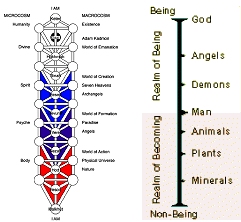
The Goal of Creation
God's primary goal of creation was a Man who was to be made in God's image. According to Lurianic Kabbalah, this original man was not Adam, however, but rather Adam Kadmon, a sort of "world soul" or semi-divine "Demiurge" through whom the other worlds were fashioned.
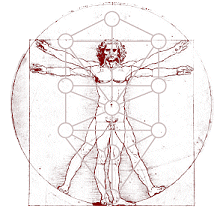 |
From within this Divine Agency/Demiurge came 32 paths of creation: the ten sefirot (numbers) and the 22 otiyot (letters) of the Hebrew alphabet, which are considered the building blocks of the universe.
Light and energy emanating from Adam Kadmon formed vessels (kelim) that were to contain the further emanations from the Infinite Source of Light (i.e., Shekhinah or the Or Ein Sof), but these vessels could not contain these emanations and were subsequently shattered (shevirat ha-kelim). This rupture in the fabric of the universe created chaos and division (tohu va-vohu) as the divine sparks became trapped in layers of darkness. The world of things became kellipot ("husks") encasing the sparks of divine light within the vessels. In the creation of otherness a cosmic tragedy had occurred: Instead of a world of perfection and beauty the world became Sitra Achra, or the "Other Side."
As a result of this cosmic tragedy of the "breaking of the vessels," Adam Kadmon himself was shattered into a multitude of individual souls, which are now trapped as kellipot. Human beings are therefore exiled and in confusion in the "Other Side." Each human soul is nonetheless a spark (nitzotz) that originated in this great Adam. The task for humanity is tikkun ("repair"), the "raising of the sparks" by "removing the kernel from the husk." This is the motivation for doing mitzvot that heal the world (tikkun ha-olam). Eventually each individual can be reconstituted in the Upper World and the lost sparks of God's Light will be restored to Adam Kadmon. Finally, God will be "all in all," and the world will be restored to heavenly perfection....
|

